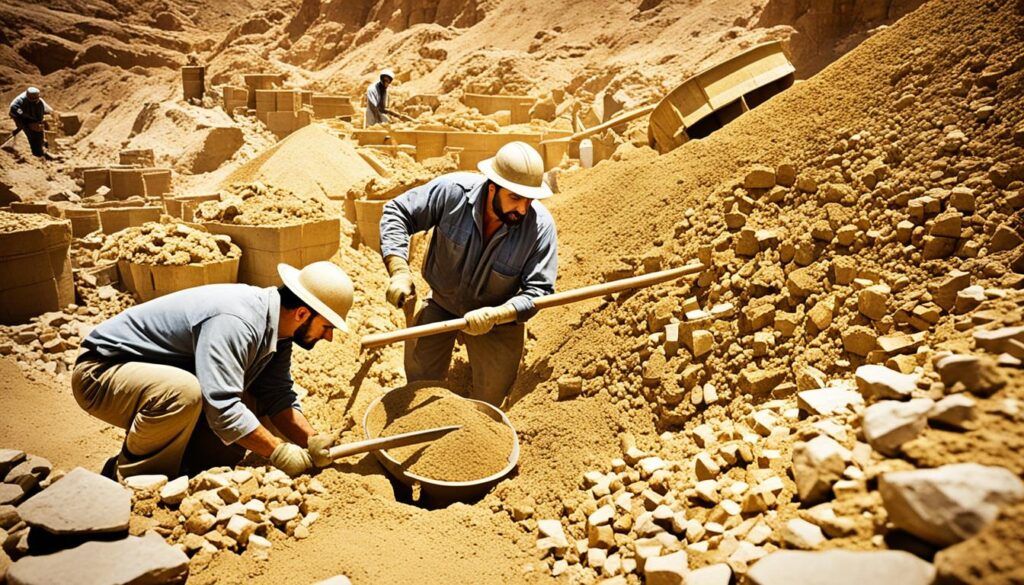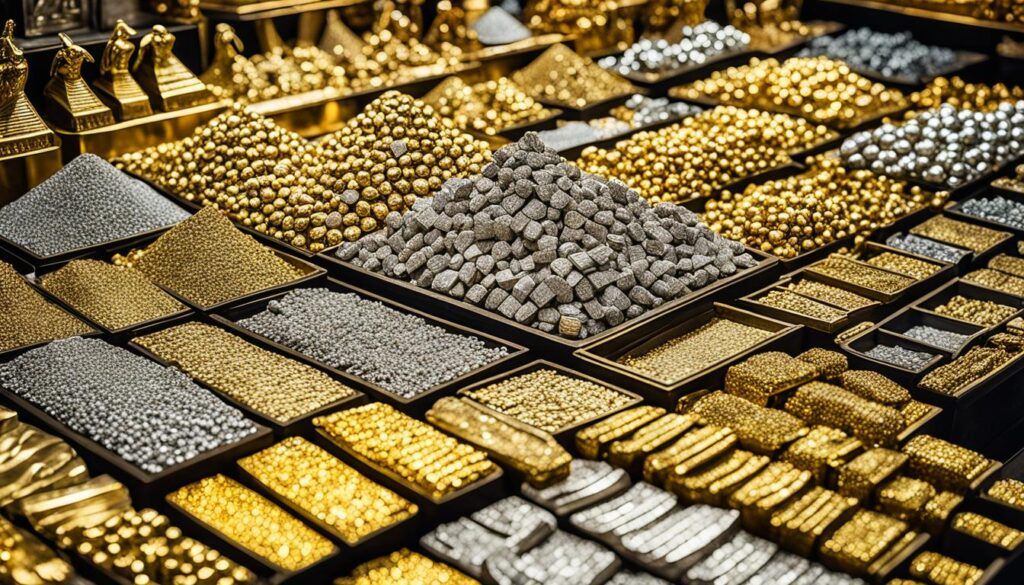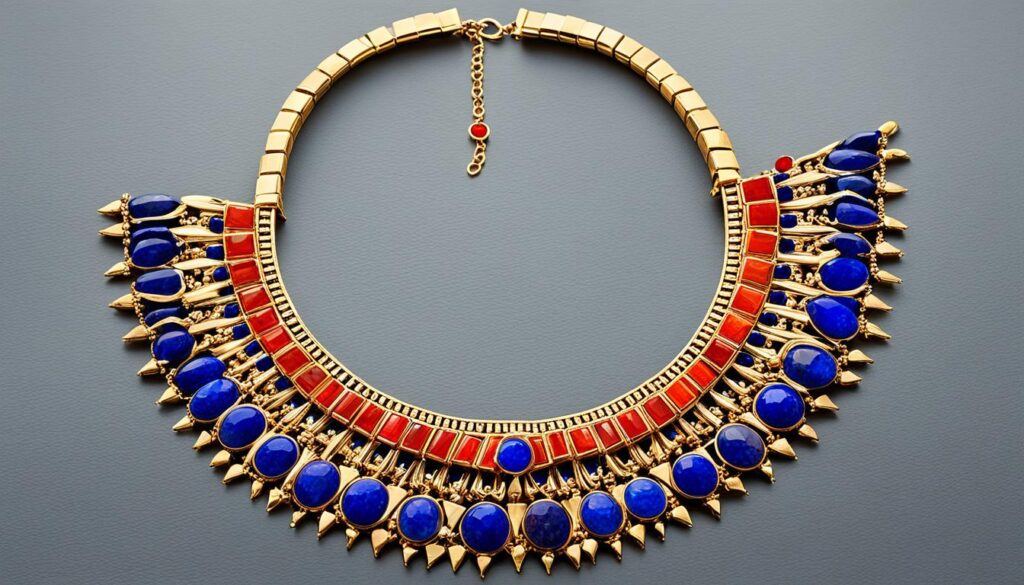Did you know that ancient Egypt had access to the riches of Nubia, which is reflected in its ancient name, nbw (the Egyptian word for gold)? This fascinating fact highlights the immense importance and historical value of gold in ancient Egypt. Gold played a central role in the culture, economy, and art of this ancient civilization, symbolizing wealth, power, and divine connections.
Key Takeaways:
- Ancient Egypt had access to the riches of Nubia, making gold a significant part of its culture and economy.
- Gold was considered a symbol of wealth, power, and divine connections in ancient Egypt.
- Gold was extensively used in the creation of jewelry, ornaments, amulets, death masks, and ceremonial objects.
- Ancient miners in Egypt were thorough in their exploitation of economically feasible sources of gold.
- Gold mining and trade played a pivotal role in the economic wealth and prosperity of ancient Egypt.
The Significance of Gold in Ancient Egypt
Gold held immense value in ancient Egypt, symbolizing wealth, power, and divine connections. It was believed to be the flesh of the sun god Ra, making it a sacred metal with profound spiritual significance. The Egyptians considered gold to be a direct link between the mortal world and the gods, connecting the ruler, pharaoh, to their divine ancestors.
Ancient Egyptians used gold to create exquisite jewelry, ornaments, and amulets, showcasing their opulence and social standing. Gold artifacts adorned the bodies of pharaohs, priests, and noble individuals, serving as a visual representation of their elevated status. These exquisite pieces of gold jewelry were not merely decorative but held great cultural and religious importance.
The intricate craftsmanship and artistic mastery that went into creating gold jewelry and ornaments were unparalleled. The use of gold in ancient Egyptian culture extended beyond personal adornment. Gold was also used to create magnificent death masks, including the famous mask of Tutankhamun, which was intended to protect the pharaoh’s body and aid in their journey to the afterlife.
“Gold never loses its shine, even in death, it serves as a guiding light for pharaohs in the eternal realm.” – An Egyptian historian
The significance of gold in ancient Egypt cannot be overstated. Its use in religious ceremonies, burial rituals, and temple offerings solidified its importance in every aspect of Egyptian society. Gold was not only a symbol of wealth and power but a means to obtain divine favor and secure a prosperous afterlife.
The Role of Gold in Egyptian Funerary Practices
Gold played a crucial role in ancient Egyptian funerary practices, ensuring the deceased’s safe journey to the afterlife. It was believed that the gods favored the pharaohs and nobles, granting them a luxurious afterlife filled with abundance and joy. Gold artifacts were carefully placed within tombs to accompany the deceased on this journey.
The gold funerary objects included amulets, such as the heart scarab, which provided protection and guidance in the afterlife. Wealthy Egyptians were buried with gold jewelry, depicting symbolic motifs and protective deities. These intricate gold pieces were intended to aid the deceased in their spiritual transformation and support their transition to the divine realm.
| Gold Objects in Egyptian Tombs | Meaning and Purpose |
|---|---|
| Gold Death Masks | To depict the deceased in their eternal form and to provide protection in the afterlife. |
| Gold Amulets | To offer divine protection and guidance for the deceased’s soul in the afterlife. |
| Gold Jewelry | To symbolize wealth, status, and to ensure the favor of the gods. |
These gold objects not only served a practical purpose but also held deep symbolic and religious significance. The use of gold in Egyptian funerary practices demonstrates the culture’s unparalleled reverence for the metal and its role in the journey to the afterlife.
Gold Mining and Trade in Ancient Egypt
Ancient miners in Egypt were highly skilled in uncovering and extracting economically feasible sources of gold. This precious metal held great value and played a significant role in the wealth and prosperity of ancient Egypt. One of the major sources of gold in the region was Nubia, which provided Egypt with access to abundant riches.
Gold mining in ancient Egypt involved various techniques and technologies employed by skilled miners. They would carefully explore and exploit gold-bearing deposits, extracting the valuable metal with precision. The meticulousness of these miners ensured that every ounce of gold was retrieved from the deposits.
Ancient Egypt’s gold trade was a testament to its abundant reserves. The gold mined in Egypt was highly sought after and exported to other regions, contributing to the country’s economic growth. This trade network facilitated the flow of wealth into ancient Egypt and solidified its position as a leading power in the region.
The trade of Egyptian gold extended beyond its borders, reaching neighboring civilizations and cultural centers. It fostered economic and diplomatic relationships, reinforcing the importance of gold in ancient Egyptian civilization.

“The gold of ancient Egypt fueled its economy, symbolizing riches and power. The country’s mining and trade operations established its dominance in the region.”
Gold mining and trade in ancient Egypt were not only essential for economic growth but also held cultural significance. The presence of gold signified wealth, prestige, and divine connections. The craftsmanship and artistic expression of ancient Egypt were also greatly influenced by the availability of gold as a precious material.
From mining to trade, gold played a pivotal role in shaping ancient Egyptian civilization, leaving a lasting legacy of prosperity and abundance.
Gold Use in Ancient Egyptian Art and Craftsmanship
Gold played a central role in ancient Egyptian art and craftsmanship. It was utilized in a wide array of objects, showcasing the skill and creativity of ancient Egyptian artists. Through various techniques such as casting, hammering, embossing, and engraving, gold was transformed into intricate jewelry, statues, vessels, and other ornamental objects.
A notable technique used in ancient Egyptian art was the application of gold leaf. This involved covering surfaces with thin sheets of gold to create a lustrous and golden appearance. The use of gold leaf added a touch of opulence and grandeur to the artwork, emphasizing the symbolic value of gold in ancient Egyptian culture.
Gold inlays were another technique employed by ancient Egyptian craftsmen to enhance bronze statuary. By applying gold inlays to bronze objects, such as statues or decorative items, the artisans created a striking contrast and highlighted the juxtaposition of materials. This technique not only added to the visual appeal of the artwork but also served as a testament to the skill and craftsmanship of ancient Egyptian artisans.
Gold Symbolism in Ancient Egyptian Art
Ancient Egyptian gold artistry went beyond mere aesthetics. Gold held profound symbolism in ancient Egyptian culture, representing the divine, the sun, and immortality. The use of gold in ceremonial objects and jewelry was believed to invoke and connect the wearer or the owner to the gods.
“Gold was considered the flesh of the gods, as it was believed to be the skin of the sun god Ra.”
This symbolism is evident in various artifacts discovered in ancient Egyptian tombs. Gold death masks, amulets, and other funerary objects were commonly placed in tombs to ensure the deceased had a safe and prosperous journey to the afterlife. These gold artifacts not only served a protective function but also emphasized the spiritual and divine associations of gold in ancient Egyptian mythology.
| Artistic Objects | Techniques Used |
|---|---|
| Jewelry | Casting, hammering, engraving |
| Statues | Casting, gold leaf application, gold inlays |
| Vessels | Embossing, engraving |
| Decorative objects | Gold leaf application, gold inlays |
Ancient Egyptian artists mastered the art of working with gold, creating captivating and enduring pieces that still awe and inspire us today. The use of this precious metal not only elevated the aesthetics of their artwork but also conveyed profound cultural and symbolic meanings. Gold in ancient Egyptian art remains a testament to the rich heritage and craftsmanship of this ancient civilization.
Other Precious Metals in Ancient Egypt
While gold held immense value in ancient Egypt, it was not the only precious metal that played a significant role in their culture. Silver, bronze, and tin were also utilized, each contributing to the richness and diversity of ancient Egyptian society.
Silver in Ancient Egypt
Silver, though scarcer than gold, was highly valued and used extensively in Egyptian culture and craftsmanship. It was employed in the production of jewelry, coins, and various ornamental objects. The shine and durability of silver made it a popular choice among the ancient Egyptians, showcasing their meticulous craftsmanship and artistic skills.
Bronze in Ancient Egypt
Bronze, an alloy made from copper and tin, held great importance in ancient Egyptian society. It was used to create tools, weapons, and ornamental objects, demonstrating the practical and artistic versatility of this metal. Bronze statues, vessels, and artwork adorned temples and palaces, showcasing the expertise of Egyptian craftsmen.
Tin in Ancient Egypt
Tin played a vital role in ancient Egypt, primarily as an ingredient in the production of bronze alloys. Bronze’s durability and versatility made it suitable for various applications, including tools, weapons, and sculptures. Although tin was not as visually prominent as gold or silver, its presence was essential in contributing to the prosperity and artistic achievements of ancient Egyptian civilization.

Gold in Art Through History
Gold has played a significant role in the world of art throughout history. Its shimmering allure and timeless beauty have captivated artists across different cultures and eras. From ancient Egyptian art to modern artistic expressions, gold has been a prominent medium, symbolizing wealth, spirituality, and cultural significance.
In ancient Egyptian art, gold held religious and symbolic importance. It was believed to embody the divine flesh of the sun god Ra, elevating it to a sacred material. Gold was used extensively to create jewelry, ceremonial objects, and death masks for pharaohs, reflecting the wealth and power associated with the ruling elite. The intricate craftsmanship and meticulous attention to detail showcased the mastery of ancient Egyptian artisans.
In Islamic art and medieval illuminated manuscripts, gold leaf was cherished for its decorative capabilities. The delicate application of gold leaf added a touch of opulence and elegance to paintings, calligraphy, and manuscript illuminations. Its radiant presence enhanced the beauty and spiritual aura of these artistic works, enriching the visual experience for viewers.
The ancient Inca civilization also valued gold for its cultural and religious significance. Gold sheets were used to craft objects of worship, such as ornaments, masks, and ceremonial vessels. These elaborate golden creations reflected the Inca’s reverence for the divine and their advanced metallurgical skills.
In Christian art, gold has played a vital role, particularly in the form of gold leaf backgrounds. The shimmering gold surfaces symbolize the heavenly realm and serve as a backdrop for religious icons, frescoes, and altarpieces. The luminosity of gold leaf adds a sense of divine radiance, evoking a spiritual connection between the viewer and the sacred subject matter.
More recently, artists like Gustav Klimt and Jeff Koons have incorporated gold into their works, exploring its cultural and artistic associations. Klimt’s opulent use of gold in his paintings, such as “The Kiss,” conveys themes of love, sensuality, and spirituality. Koons, known for his provocative sculptures, has used gold to challenge traditional notions of art, blurring the boundaries between high and low culture.
In summary, gold’s presence in art spans centuries and continents. Its use in ancient cultures, such as Egypt and the Inca civilization, showcased the importance of gold in religious and cultural practices. In Islamic, medieval, Christian, and modern art, gold continues to evoke a sense of beauty, spirituality, and artistic expression. Its timeless radiance remains a testament to the enduring allure and significance of gold in the world of art.
Conclusion
In ancient Egypt, gold held immense value and played a central role in shaping the culture and society of the time. It represented not only wealth and power but also divine connections. The Egyptians extensively used gold in art, jewelry, and ceremonial objects, creating awe-inspiring pieces that showcased their craftsmanship and reverence for the metal.
Gold mining and trade were crucial components of Egypt’s economy, with access to the riches of Nubia providing a significant source of gold. While other precious metals like silver, bronze, and tin were also utilized, it was gold that stood out as the most prized material, symbolizing the highest status and luxury.
Furthermore, the allure and significance of gold have transcended time. Artists throughout history have been captivated by its beauty and incorporated it into their works. From ancient Egyptian art to medieval manuscripts, from Inca religious objects to contemporary masterpieces, gold has continued to captivate and inspire, leaving a lasting impression on art and culture.
FAQ
Why was gold so valuable in ancient Egypt?
Gold was considered a symbol of wealth, power, and divine connections in ancient Egypt. It was used to make jewelry, ornaments, amulets, death masks, and other ceremonial objects. Gold was believed to be the flesh of the sun god Ra and was used to ensure a safe journey to the afterlife.
What role did gold mining and trade play in ancient Egypt?
Ancient miners in Egypt were thorough in their exploitation of economically feasible sources of gold. Egypt had access to the riches of Nubia, which was a major source of gold. The gold trade in ancient Egypt was also significant, with the metal being exported to other regions. Gold played a pivotal role in the economic wealth and prosperity of ancient Egypt.
How was gold used in ancient Egyptian art and craftsmanship?
Gold was extensively used in ancient Egyptian art and craftsmanship. It was shaped into jewelry, statues, vessels, and other ornamental objects using techniques such as casting, hammering, embossing, and engraving. Gold leaf was applied to surfaces to create a golden appearance, and gold inlays were used to enhance bronze statuary. Gold played an integral role in the artistic expression of ancient Egypt.
Were other precious metals used in ancient Egypt?
Yes, in addition to gold, other precious metals such as silver, bronze, and tin were also used. Silver, although scarcer than gold, played a role in Egyptian culture and craftsmanship. Bronze was used to create tools, weapons, and ornamental objects, while tin was mainly used to produce bronze alloys. These metals contributed to the richness and diversity of ancient Egyptian society.
How has gold been used in art throughout history?
Gold has been used in art for various purposes throughout history. In ancient Egyptian art, gold had religious and symbolic significance. In Islamic art and medieval illuminated manuscripts, gold leaf was used for decorative purposes. Gold sheets were used in Inca culture for objects of religious and cultural importance. Gold was also utilized in Christian art, often in the form of gold leaf backgrounds. In modern art, artists like Gustav Klimt and Jeff Koons have incorporated gold into their works, exploring its cultural and artistic associations.
What is the significance of gold in ancient Egypt?
Gold held immense value in ancient Egypt, symbolizing wealth, power, and divine connections. It was extensively used in art, jewelry, and ceremonial objects. Gold mining and trade played a role in Egypt’s economy. While other precious metals were also utilized, gold stood out as a material of paramount importance. Throughout history, gold has continued to captivate and inspire artists, showcasing its enduring allure and significance.



